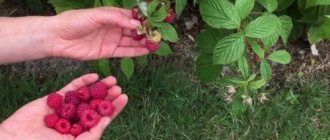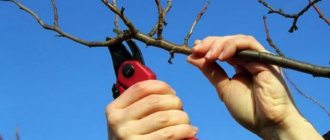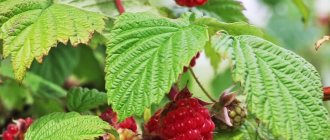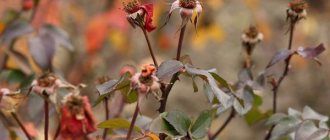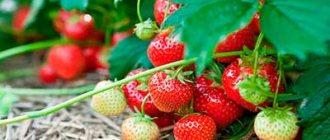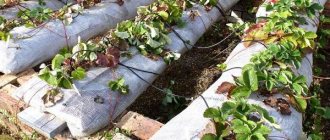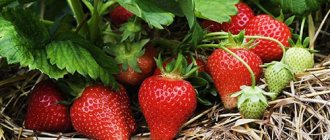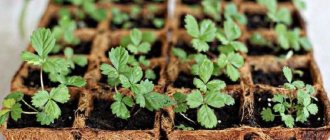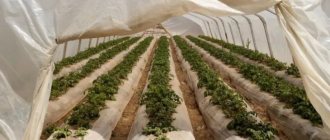OgorodGuruCom
Tips and tricks for gardeners
Popular
Technology of growing Crystal grapes - main features of the variety
Home › Berries › When and how to prune remontant raspberries for the winter
Raspberries are tasty, nutritious and have a whole range of medicinal properties. In most cases, you can enjoy the harvest of these berries only for a short period of time in the summer, but thanks to the emergence of new varieties of remontant raspberries, you can harvest until frost. Gardeners who have chosen to grow remontant varieties should take into account that crop care and pruning technology differ from standard ones and have certain features.
Why prune raspberries in the fall?
Non-repairing raspberry varieties are characterized by a 2-year development cycle - young plants bear fruit only in the second year. Only on two-year-old shoots will flower buds form, and only on them will there be berries. One-year-old young shoots have only leaves. The branches, having bear fruit in the second year of life, produce significantly fewer berries in the third year, many dry out and die.
The gardener’s task is to promptly eliminate fruit-bearing branches. Why is it important to prune them in the fall:
- The young growth that grows to replace the old branches will receive the proper amount of light and nutrients - this will allow them, having become stronger before winter, and without freezing, to survive the winter safely.
- The number of pests that move to winter not only in the soil and fallen leaves, but also in dead stems is reduced. The latter often become a source of mold and fungi.
Autumn pruning is also aimed at combating growth - if it is not removed, the raspberry bush will quickly run wild and turn into thickets. Shoots growing from rhizomes grow quickly in warm weather. One bush produces up to 20 shoots, which draw juices from it, preventing normal fruiting.
Reasons for fighting shoots:
- It is difficult to pick berries in the raspberry wilds.
- There are few berries and they become smaller - the yield of the bushes decreases.
- An obstacle is created to the free circulation of air and the penetration of sunlight - this contributes to the development of diseases and causes the appearance of pests.
- The root shoots can move 3 m or more away from the mother bush - this leads to the “spreading” of the plantings.
Further preparation for winter
Work on the berry patch continues. The plant needs to be fed so that it has enough strength to prepare for winter. The soil needs to be saturated with moisture; succulent shoots tolerate frost better. The ground is cleared of cuttings and weeds. Mulching is done to retain moisture. It is worth telling about each operation in more detail.
Proper feeding
Removing unnecessary branches is not the final stage of preparation for winter; you still need to know how to feed raspberries in the fall after pruning.
In the fall, after pruning, add some natural ingredients:
- Manure is incorporated into the soil in a thin layer. The unrotted one performs the function of biofuel and gives heat to the roots. Last year's is a source of nutrients. The most useful manure is horse manure, followed by cow manure. It is better not to place pork with sawdust on raspberries; first they let it rot well.
- Chicken droppings in their pure form burn plants. It is diluted in water at the rate of 200 mg per bucket.
- Compost is more valuable in nutritional value than humus; it is laid out in a layer of 5–7 cm around the shoots. The norm per 1 m2 is up to 7 kg (this is a bucket of dry).
- Take rotted peat, mix it with wood ash, add a glass to a bucket.
After feeding, raspberries replenish their reserves of nutrients and lay flower buds. Per 1 m2 add 40 mg of superphosphate and 20 mg of potassium sulfide. These comprehensive supplements contain essential macronutrients.
Sanitation
Spraying with fungicides protects against fungal diseases, rot, and mosaic. Bordeaux mixture is effective against insects. It is advisable to carry out the treatment before the foliage has completely fallen. Liquid laundry or green soap is added to the solution for better adhesion.
Watering
Usually by the end of summer in temperate latitudes it begins to rain, then watering is not required. If August turns out to be dry, the soil is well watered so that it is saturated to a depth of 40 cm. With the onset of frost, watering is reduced. During this period, the shoots will become woody and gain the necessary strength.
Mulching
Mulching serves to protect the roots from extreme cold until permanent snow cover has established. For mulch use:
- dry humus;
- rotted sawdust;
- straw;
- crushed bark.
Cover the soil with a layer of up to 8 cm. It has been proven that this is enough to prevent the ground from freezing to a great depth. In the northern regions, the layer is doubled; only in the spring, after the snow has melted, it is important to clear the mulch in time, otherwise the trunks will prop up and crack from below. It is recommended to add fresh pine needles to the mulch to repel mice.
Frost protection
When is it better to cover raspberries well:
- if it is a productive sugary variety, such berries are heat-loving;
- severe frosts are expected;
- winters with little snow;
- if the raspberry is thornless, it will become easy prey for rodents.
Proper preparation consists of bending the shoots to 1/3 of the height. As soon as the morning performances begin, you can sprinkle the prepared rows with spruce branches. It is convenient to tie branches to wooden pegs; you can drive nails into them on all sides. The end of the twine is wound onto the shoots and pulled down, bending them at an angle of 60°.
Bushes are protected from rodents with netting, barbed wire or spruce branches, and poisonous baits are laid out on cleared ground. Residents of northern latitudes are advised to bend raspberries as low as possible and cover the shelters with tops and dry branches. In windy areas, snow protection is made - sheets of plywood or polycarbonate are installed on the leeward side.
The branches bend when the air temperature is above +10°C; in the cold they become fragile.
Exact terms and conditions of pruning
Autumn is considered the best time to prune raspberries. The main thing is not to postpone this event until frost. When the harvest ends, many pests accumulate on the bushes - it’s time to destroy them by pruning and eliminating excess branches by burning. Otherwise, these shoots will be parasitized by insects that nourish their bodies before wintering.
Deadlines by region
After pruning, there is still a month and a half left before frost, during which time the plants have time to accumulate nutrients for the future harvest. Table 1 shows the timing of autumn pruning for different regions of Russia.
Table 1
| Region | Timing of pruning |
| Middle lane | from the second ten days of August to the second ten days of September |
| Ural and Siberia | throughout August |
| South of Russia | from mid-July to mid-October |
Raspberries are pruned no later than three weeks before freezing temperatures set in.
When choosing a pruning time, consider the forecast for your area. It may be necessary to adjust the dates due to the early cold weather.
The timing of pruning also depends on the type of raspberry:
- On ordinary raspberries, pruning is carried out after picking the berries - the exact timing is difficult to determine in advance; the onset of frost must be taken into account.
- There is no rush to prune remontant raspberries - they bear fruit until late autumn. Typically pruning is done after the leaves have dropped.
Dates according to the lunar calendar
Pruning of raspberry bushes is carried out during the waning Moon, in the 3rd and 4th phases. During this period, the juices in the plants move from the growth point towards the roots - under such conditions pruning is most favorable. It is not recommended to prune raspberries during the full moon, new moon or on the 23rd lunar day.
In the fall of 2022, it is best to prune raspberries on the following days:
- September 2, 5, 7, 9, 20 and 28;
- October 1, 4, 5, 10, 29, 31;
- November 3, 7, 8, 11, 28, 30.
The 3rd, 6th and 8th lunar days are favorable for any work, including pruning bushes.
It is not recommended to prune bushes:
- October 1 and 28;
- November 1st and 26th.
The best moon days for pruning bushes are in Aries, Leo and Sagittarius.
Is pruning necessary in summer?
In the summer, two-year-old branches that managed to bear fruit during the first berry harvest must be cut down at the root. This is necessary so that the plant accumulates strength for the growth of the current season for the second fruiting.
In addition, in the summer, to increase productivity, it is worth removing dry and non-viable branches so that the remaining shoots get more nutrients.
In addition to all of the above, there are also semi-remontant raspberry varieties, for example, Indian Summer, Yellow Giant, Kostin Brodskaya, which, unlike the described crop, under certain conditions give a second harvest only at the apical ends of the branches.
Let us note once again that a fully remontant variety sets fruit along the entire length of the shoots of the current season.
If a shrub with partial signs of a second fruiting is pruned “to zero” in late autumn, disturbances in the formation of fruits will occur. They will not be available in the summer, and the autumn, very modest harvest, will be moved to a later date.
Processing of such varieties is done according to the following method:
- In autumn, that part of the growth that was actively bearing fruit is removed;
- In the spring, sanitary and standardized pruning is done with the removal of excess branches that thicken the bush;
- In the summer, two-year-old branches are removed, which have had time to bear fruit in the usual time for traditional berry bushes.
But whether it is necessary to prune gooseberries in summer can be found out in this article.
Necessary equipment
All instruments are prepared in advance - sharpened and disinfected. Dull cutting parts will damage the branches, impairing the frost resistance of the bushes. An undisinfected instrument can carry various diseases, infecting raspberry bushes.
Tools required for cutting:
- Secateurs. The main device for removing excess branches and growth. It can be replaced with pruning shears.
- Lopper. Can be useful for trimming thick stems.
- Garden knife. Necessary for correcting unsuccessful, uneven pruning.
- Rake. They are used to remove trimmed branches and leaves.
How to rejuvenate old raspberries by pruning: diagram, tips
Rejuvenated raspberries using pruning
It often happens to inexperienced gardeners that they do not properly care for the raspberries. Because of this, raspberries become overgrown with young growth, weeds and old stems. Naturally, productivity drops significantly. But you can rejuvenate old raspberries by pruning. Here is the diagram and tips:
- In the spring, after warm weather has established, cut each stem to a height of 1 meter . Leave 2-3 strong branches or, if the bush is powerful, then 4 or 5 branches. Cut off weak, frostbitten, twisted, dry branches.
- Thin out the planting well, without worrying about cutting off excess. The more spacious the bed, the better the harvest.
- The aisles must be clean : meter rows must alternate with half-meter aisles.
- Remove young growth in a timely manner.
Tip: In addition to pruning, you need to mulch the soil (hay, straw, leaves, grass), and water the bushes abundantly.
After all the manipulations done, raspberries will give a good harvest this year. After harvesting, trim off any shoots that have produced fruit and pinch off the tops. In the fall, you can add fertilizer, for example, ash.
Remember that your efforts will not be in vain. Pruning for the purpose of rejuvenation will help turn an overgrown bush into a super-yielding giant. In addition, not only the number of berries will increase, but also their size.
Basic Rules
Autumn pruning combines the removal of infected, damaged and dry shoots with the complete elimination of shoots. The event is carried out in compliance with several technical rules, the same for any variety of raspberries.
Technique
When pruning in autumn, it is important to follow these rules:
- To avoid thickening of plantings and excessive foliage, pruning is planned so that the branches do not overlap each other, but are arranged in a fan.
- First, all two-year-old shoots are removed. This is done immediately after harvesting. And they cut them off to the very root.
- Broken and damaged branches are also removed to the very roots, not even leaving stumps. Damaged branches, if left, will take a lot of energy from the plant, and the berries will still grow small and tasteless.
- Whether to remove annual shoots or not depends on the climate. During warm winters, they can be left tied in bunches so that the wind does not fray. In regions with harsh winters, young growth is pruned and plantings are covered. Young shoots, not having time to become woody, often freeze and die.
- Shoots that grew in the middle of summer are removed - they are too weak to survive the frost.
At what height is the pruning done?
How to determine the cutting height:
- The tops of young shoots are trimmed so that the height of the shoots is 1.2-1.5 m.
- If young shoots are poorly developed, they can be pruned to 1 m.
- Weak tops are cut off to the first healthy bud.
- Approximately 25 cm is removed from each branch.
The result will be a planting in which all bushes will have equal height.
Shoot height
Pruning raspberries in autumn - picture
Stems with brown trunks and thickening shoots are cut out to the very roots. Place the pruning shears at ground level or slightly deeper. If you leave hemp above the surface, insects and pathogenic bacteria will settle in them. The remaining branches are usually shortened to 2 meters to make it convenient to pick berries, but at what height to cut raspberries in the fall, you should also choose the type of berry.
Tops that are too elongated are cut off to stimulate the formation of lateral processes. There are many inflorescences on them. The sooner you pinch them, the better the trunks will branch. Some productive varieties produce the main harvest on the lateral shoots.
Methods for pruning raspberries
Raspberry varieties differ in the type of fruiting, shoot growth rate, frost resistance and other varietal characteristics. Depending on the latter, the optimal pruning method is chosen.
In fast-growing raspberries, the shoots are shortened more than in varieties with normal growth.
Regular pruning
In raspberry fields that are not cultivated in the summer, all pruning work is done in the fall. Pruning conventional raspberry varieties comes down to removing shoots:
- broken;
- damaged by diseases and insects;
- two-year-olds;
- parts of annual shoots - to thin out the berry patch.
All of the above branches are removed completely - to the root.
An overview of autumn pruning of raspberries can be seen in the video below:
Pruning remontant raspberries
Remontant varieties, unlike ordinary ones, produce several harvests per season. They bear fruit not only on two-year-old shoots, but also on one-year-old shoots. These features must be taken into account when pruning. The Sobolev method is used here after the last harvest. But autumn pruning is carried out only in the southern regions; in the northern regions and in Siberia, remontant raspberries are pruned in the spring.
Autumn pruning of remontant raspberries is carried out only after the last wave of fruiting has stopped. It does not always happen that there are three weeks left between the end of fruiting and frost, since remontant varieties tend to bear fruit until late autumn.
Autumn pruning of remontant raspberries:
- The 2-year-old branches that bear fruit are cut to the surface of the ground.
- Annual shoots are shortened by 20 cm. The cut parts are raked and burned, and the bushes themselves are sprayed with Bordeaux mixture.
- In the spring, before the buds open, sanitary pruning is carried out, cutting out all frozen, dry and broken branches.
There are two types of pruning of remontant raspberries:
- For one harvest. This option is usually chosen for commercial cultivation - if the gardener wants to get one harvest, but as abundant as possible. The essence of the method: After waiting for the first frost, all bushes are cut off at the root. If pruning is done earlier, young growth will sprout, freeze, and the raspberry tree will die.
- In spring, young plants are carefully thinned out, leaving 3-4 stems per bush.
- First, after the first harvest of berries, two-year-old branches that bear fruit are cut off at the root. All the same, next year there will be little fruit for them.
If you add up the volume of two harvests, it will be comparable to the productivity of conventional varieties that produce one harvest. At the same time, the shelf life of the fruit improves.
Pruning the Cumberland variety
Cumberland is a variety of black raspberry whose shoots grow extremely quickly. This means that the usual methods of pruning Cumberland and similar raspberries will not be enough. The usual approach will lead to thickening of the planting, the bushes will look overgrown, and their immunity and productivity will drop. To maintain the normal condition of the bushes, this black raspberry will require two prunings per season.
After watching this video, you will learn how to prune the Cumberland raspberry variety:
Cumberland pruning scheme:
- The first pruning is summer. Its goal is to increase productivity. The optimal time is the end of June. Young growth is trimmed at the growth point. Their place next summer will be taken not by one new branch, but by several fresh shoots at once. In practice, it has been proven that one bush can produce an excellent harvest - without losing the size and taste of the berries, with 10-12 fruiting shoots. Stems over 2 m high are cut by 10%. This must be done on time, since the growing side shoots, if the pruning is delayed, will not have time to fully develop and will die in the winter.
- The second pruning is autumn. This is sanitary pruning, which begins when the plant goes into a dormant period. This time, depending on the region, occurs from mid-October to early November. The order of autumn pruning: cut off broken, damaged, diseased and dry shoots;
- thin and weak shoots growing deep into the bush or downwards are also removed;
- excessively long shoots that exceed the height of the trellis are cut to its size (remove up to 1/3 of the length of the branch, no more);
- last year's side shoots are shortened by 20-30 cm - they will produce berries next year;
- branches 2-3 years old are cut as close to the ground as possible, leaving no more than 10-12 shoots.
Gardeners are often afraid to trim Cumberland right down to the stumps, but this is the method that allows them to achieve a good harvest.
Trimming scheme according to Sobolev
The method of Sobolev, a famous amateur gardener from Kurgan, became known in the 80s of the last century. An enthusiast spoke about it in the magazine “Homestead Farming”. The method made it possible to increase productivity - 135 kg of berries were collected from a control plot of 50 acres, which was a lot for those times.
Sobolev improved double pruning by making some adjustments to it:
- According to the Sobolev method, the tops of the shoots are also pruned in the month of May, leaving stems 1 m long. The roots will easily cope with the nutrition of the above-ground part, and the shoots will not break under the pressure of the wind.
- The following spring, two operations are performed at once in one approach - they cut off the tops of young shoots and side shoots that grew last year.
- By July, the raspberry tree, processed according to the Sobolev method, consists of: annual flowering stems;
- branching two-year-old shoots with many flowers, ovaries and berries;
- young growth.
Pruning raspberries using the Sobolev method is presented in the following video:
The disadvantage of this method is the intensive overgrowth of bushes, thickening the plantings. Ventilation of the raspberry tree decreases, most branches are shaded, and the risk of pests and infections increases. To prevent thickening, an interval of 1 m is maintained between bushes, and 2 m between rows.
Formative pruning is carried out as follows:
- In the first year, no more than a dozen branches are left on the bush.
- In the second year, fruit-bearing shoots are replaced with fresh ones, but the number of branches is reduced to 8.
- Every year the number of replacement stems is reduced by 2 pieces.
- The final stage of bush formation involves 4 young branches.
Sobolev’s method increases productivity, but requires thorough thinning of the berry garden throughout the entire growing season - excess growth must be trimmed off in time.
The Sobolev method allows you to collect up to 6 kg of berries from one raspberry bush.
Autumn pruning technology
Pruning remontant raspberries is an agrotechnical technique that involves not only removing shoots, but also a number of other care actions. When preparing plantings for winter, a certain algorithm is followed. But before proceeding directly to the procedure itself and figuring out what to do with remontant raspberries in the fall, you should prepare the necessary equipment.
Required Tools
A lot depends on a quality tool. Using low-quality or dirty tools can lead to disastrous consequences for plants and make pruning difficult.
To perform pruning you will need the following tools:
- well-sharpened garden pruning shears, which should first be disinfected;
- a sharp knife that will be used to trim small shoots;
- a rake to remove old mulch and pruned shoots from the area;
- rough gardening gloves to protect your hands from damage.
In addition, organic fertilizers that will be used as mulch should be prepared in advance. The manure must be rotted and dry, otherwise the roots of the plant may get burned.
Algorithm for preparing raspberries for winter
By adhering to a certain technology, you can not only keep the area with raspberries in excellent condition, but also get a full harvest of berries twice a season.
Shoots are cut at the root
The step-by-step process looks like this:
- two-year-old shoots are cut at the root using sharp pruners;
- partially remove annuals, leaving no more than 7 on one bush;
- annual canes are tied to a support and the dry part of the top is cut off;
- Young shoots between the rows should be cut at the roots or, if possible, uprooted.
Important! All work in the raspberry field is carried out with sharp and pre-disinfected tools, and rough work gloves are also used.
If you plan to get one raspberry harvest next year, prune all shoots without exception. In this case, special attention should be paid to the thickness of the mulch layer - on the bush itself it should be thicker than on the rest of the site.
What to do after pruning?
After pruning, the bushes need support in the form of fertilizing and watering so that they can more easily survive stress. Activities after autumn pruning of raspberries:
- Feeding. Add compost, peat, and bird droppings solution. You can add superphosphate - 50 g, and potassium sulfate - 40 g per bush.
- Watering. After feeding, the raspberry tree is watered abundantly. Watering rate is 50-60 liters of water per bush.
- Spraying. Remontant varieties are sprayed with Bordeaux mixture for disinfection. Regular raspberries are sprayed with fungicides in the spring.
- Mulching. After absorbing moisture, the plantings are covered with a thick layer of mulch. They use any organic matter, but for the winter, it is best to sprinkle the soil with pine needles - it will not only protect the plantings from frost, but also from rodents.
- Shelter for the winter. Gardeners in the southern regions and the Middle Volga region may not cover raspberries for the winter - if the variety is zoned in these regions. In areas with harsh winters, it is recommended to cover the berry garden. To do this, the branches are tied into bundles and bent to the ground. If the winters have little snow, the plantings are covered with leaves - a layer of 30 cm. If the raspberry plant is covered with a film on top, ventilation holes must be made in it.
You can’t cover raspberries too early - they run the risk of drying out. If you delay with the shelter, the branches will become brittle and you won’t be able to bend them down.
Caring for bushes after pruning: seasonal differences
After pruning, it is necessary to carry out other work to care for remontant raspberries:
- Immediately after the procedure of pruning the shoots, it is recommended to mulch the soil around the bushes, since it is not worth loosening the soil around them due to the fact that the root system is on the surface and can be easily damaged.
- During the entire warm period, it is necessary to water, and especially during the period of berry appearance.
- To obtain a good harvest, appropriate fertilizing should be carried out. In March, complex fertilizers are applied, and before the appearance of color and in the fall, when the bushes stop bearing fruit, potassium-phosphorus fertilizers (superphosphate, potassium sulfate) are applied.
- It is also necessary to prevent diseases and insect pests.
- In the fall, after pruning, you should dig up the soil between the rows and insulate the roots of the bushes by mulching with a layer of 10 cm. Humus, manure, and straw are well suited as mulch.
Do I need to prune remontant raspberries before winter?
In regions with harsh winters, it is recommended to cut off all shoots - annual and biennial, being careful not to leave stumps. Then the autumn harvest will be as abundant as possible. If the gardener wants uniform fruiting - in two stages, then annual shoots are left for the winter.
True, in regions with harsh winters they must be covered. If you don’t want to bother with the shelter, then it’s better to cut off everything – both two-year and one-year-old shoots. And only in the south is it better to leave annual trees for the winter without pruning them.
In the video below, the gardener shares his experience of preparing remontant raspberries for winter:
When and how to properly prune regular, red, yellow, black raspberries in the summer, after harvesting?
Regular red raspberries with proper pruning
Summer pruning is important for any raspberry variety. After picking berries - in July or August, on red, yellow and black raspberries, follow these steps:
- Cut all the branches on which the berries ripened to the surface of the soil. Don't leave any stumps! They have already fulfilled their function and are not needed by the plant, but will only take away the juices and prevent the young growth.
- Try to promptly limit the growth of the crop in width . Thanks to this, it will be possible to maintain excellent yields. The fruitful branches that will grow in the center will quickly develop, grow and produce a lot of berries.
- Throughout the summer - 2-3 times a month, remove all shoots that emerge from the soil . Leave only those that are located more than 20 cm from the central bushes, that is, you should end up with even raspberry beds, and not thickets overgrown with young shoots. If this is done regularly, then such a process will not require much effort and time.
Important to know: Young shoots that have just emerged from the soil do not need to be pulled out or dug up. Simply trim the growth that is located below the surface of the soil by sticking a shovel in and it will dry out on its own.
In addition, shorten the shoots of red and yellow raspberries by 20 cm, and those of black raspberries to 40 cm . Black raspberry-blackberries stretch to a length of more than 2.5 meters; after trimming the top, about 2-2.1 meters of stem should remain.
Gardener mistakes
Most novice gardeners often make mistakes when pruning raspberries. Most often, beginners make the following mistakes:
- It is a pity to cut off strong young growth - beginners think that by cutting it, they are depriving themselves of the future harvest. This “psychological barrier” must be overcome - without pruning, the plantings will become sick, the berries will become smaller, and the yield will fall. This is the biggest and most common mistake novice gardeners make.
- Not all branches to be pruned are removed. Beginners often start pruning from the outer branches. When cutting out young shoots, they remove mainly the outer shoots without going deep into the berry garden. As a result, the center of the raspberry tree becomes thickened - this leads to a decrease in yield and the appearance of diseases. Be sure to be patient and remove shoots in the center of the plantings.
- Do not remove intertwined branches . By not pruning branches that are close to each other and intertwined, gardeners increase the risk of disease. When branches come into contact, they lose their protective layer and become vulnerable to microbes.
- Incorrect pruning pattern . Often gardeners only shorten shoots that should be cut off completely. They cut out only dry and broken branches and leave the rest. Sanitary pruning is not enough - formative pruning is also needed, on which the future harvest depends.
- When pruning, the buds are damaged . To prevent this from happening, it is important to follow the pruning pattern. First, remove all large branches, then the smaller ones. Then pruning goes faster and without damaging the buds.
Deadlines
Autumn pruning should be done after the leaves fall, feeding the plant before the onset of cold weather. In mild winters it can be postponed until early November. It’s okay if the first snow manages to fall during this time.
Important! If you rush with autumn pruning, the root buds may awaken, which will lead to a decrease in crop yield in the next season.
In the spring, treatment should be done when “live” buds can be identified in order to remove dead parts. This time usually falls in April. Optional summer pruning of one-year-old shoots is done after the plant has grown about 0.9–1 m (in May), and two-year-old shoots - after fruiting.
When is it better to prune, autumn or spring?
Autumn pruning can be replaced with spring pruning in regions with relatively warm winters. But you need to be sure of good snow cover so that the young shoots left for the winter do not freeze out. If they freeze, the gardener will suffer losses. From the point of view of raspberry plant safety, autumn pruning looks like a more reliable agricultural measure.
In general, raspberries are pruned several times a season. During the growing season, one root can produce up to two dozen young shoots. In spring, pruning is carried out for sanitary purposes and to awaken the buds. In autumn - for the purpose of forming a bush and to prevent freezing. Therefore, both options are important for raspberry growers.
Why spring pruning is needed:
- This is a continuation and addition to the pruning done in the fall.
- It starts immediately after the snow melts. Remove all shoots that the bush does not need - weak, diseased, frozen over the winter, broken. Trim them as low as possible, without stumps.
- Then the tops are cut off - if the shoots were left for the winter, by 20 cm, to healthy buds. This causes the awakening of the upper buds, forming 3-6 shoots with berries. If the tops are not cut off in the spring, the berries will be small.
As you can see, spring pruning pursues its own goals, and one cannot refuse it. Moreover, it is recommended to prune raspberries in the summer. By cutting off wilted or diseased tops during the flowering period, gardeners prevent infection of neighboring bushes. Also in the summer, shoots are removed, preventing the depletion of raspberry bushes.
Trimming scheme: features
Due to the ability to bear fruit on annual shoots, pruning of remontant raspberries can be done in different ways. Cutting off all branches in the fall is considered the most optimal.
Check out
When and how to prune raspberries correctly? It will allow you to get only one harvest from the end of summer until frost, but it will be the most abundant. If you prune it as usual, leaving shoots for the second year, then it will bear fruit 2 times per season, but the harvest will not be more.
In this case, repeated fruiting will be several weeks later and much smaller. When pruning, you should also take into account the climatic conditions of raspberry growth.
In the northern regions, it is recommended to prune bushes in spring, since the branches left behind help the plants survive the winter. In the middle zone and in the south it is better to prune in the fall.
in autumn
This is the most effective type of pruning, allowing you to avoid summer fruiting and harvest a bountiful harvest in August-September. During it, all branches are cut at a distance of 4 cm from ground level.
Then old mulch, debris and cut branches are removed from the bush, which are then burned. Abundant watering and loosening is carried out. Mulching is carried out with humus or rotted manure. This will help the raspberries survive the winter and prepare them for the next season.
Such short pruning is an effective agricultural technique that increases the winter hardiness of the crop and helps to avoid pests and diseases. Berries from such raspberries are more environmentally friendly, since there is no need for chemical treatments.
Important! Plants planted this season should not be shortened significantly, as this interferes with their rooting. They are left up to 20 cm high.
in spring
When pruning in spring, dried and frozen branches are removed down to the first “live” bud. In such conditions, diseases and pests often multiply. If plants were attacked by pests and diseases in the previous season, then appropriate preparations should be used after this procedure. Typically, iron (copper) sulfate (1%) or Nitrafen is used.
During a year
Summer pruning is usually done during two fruiting periods in order to increase the yield of the second wave.
To do this, immediately after the first harvest leaves, do the following pruning:
- Remove fruit bearing branches.
- Too weak shoots and branches that thicken the planting, young shoots and replacement shoots growing near the ground are cut off.
The second point can also be performed when pruning to obtain one crop on annual shoots.
If desired, they also have the tops pinched in May when they reach a height of about a meter. This will increase the number of fruit branches and extend the fruiting period, but slightly delay its start time. This technique also stimulates the appearance of more root shoots.
How does autumn pruning differ in different regions?
The differences in pruning are related to the climate; it is he who makes adjustments to its technique:
- In the central regions of the Russian Federation and in the Moscow region in particular, young shoots do not need to be pruned for the winter. It is enough to tie them and cover them. This method allows you to use snow as a natural insulation. But the use of artificial covering materials can be harmful - condensation often forms under it, which provokes the development of fungal diseases.
- In Siberia, autumn pruning is a mandatory agrotechnical activity. The winters here are so cold that you can’t do without shelters, and pruned bushes make it quick and easy to cover your raspberry patch.
- In the Krasnodar Territory, pruning is carried out in late autumn. Gardeners have time to get another autumn harvest. True, autumn raspberries are small and there are very few of them, but it’s still nice when the bushes continue to bear fruit at such a late time.
Raspberries are unpretentious and bear fruit under any conditions, but if you are interested in a good harvest, in large and sugary berries, then do not be lazy to trim the raspberries on time. You should pay special attention to autumn pruning - it is important to correctly calculate the timing and follow the technique of this important agricultural activity.
0
0
Copy link
Reviews
Katya P: Do I need to prune raspberries in the fall? The clear answer is yes. In this way, I increase productivity in the new year, which is what I wish for you.
Andrey Ch: I started thinning out the raspberries in the fall, as recommended. I noticed results the very next year. There were fewer branches, but more berries were collected from them.
Marina N: I always cut raspberries in the spring, but once I tried them in the fall. I liked that in the spring time is freed up for gardening. As soon as I pick the last raspberries, immediately behind the pruning shears.
Stepan R: In the fall it is easier to identify unnecessary young shoots, they are not so strong. When you leave 5–7 pieces on a bush, the remaining branches branch more strongly and bloom more abundantly. Productive varieties run wild without pruning and the berries become small.
Remontant raspberry - what is it and what is its feature
Remontant varieties are those that bear fruit on the shoots of the first and second year. Regarding raspberries, the concept “remontant”, which comes from the French language, means bearing fruit repeatedly. Such raspberries have been known for about 200 years in Europe. At the beginning of the 19th century, 20 similar varieties were cultivated; in the next century, their number exceeded 60.
The “Autumn Beauty” variety has a rich taste
Caring for raspberries in spring
If the raspberry bushes were planted at the beginning of the season, before the buds opened, then after planting they are shortened to 20 cm. At first, they must be shaded with non-woven light material to protect the fragile plants from the bright sun or cold night temperatures. It is also necessary to monitor soil moisture by watering regularly. In the future, they care for young plantings in the same way as for adult raspberries.
Raspberries are planted in the spring before the growing season begins.
Spring pruning
In early spring, when the buds are just beginning to swell, sanitary pruning of shoots left to overwinter is carried out. Remove those branches that are frozen, dried out or broken. Trim the frozen parts of the stems to the first healthy bud.
In the spring, sanitary pruning is carried out, removing broken or frozen stems
It is important not to allow plantings to thicken. In early May, when new shoots grow to 30 cm, it is necessary to thin out the bushes, leaving 7–10 of the strongest branches. At the same time, the raspberry receives the living space it needs, solar heat, light and nutrition, which has a beneficial effect on productivity.
Remontant raspberries do not tolerate thickening, so in May the bush is thinned, leaving 7–10 of the strongest shoots
On a bush that has reached a meter in height, the tops of the shoots are pinched. This helps to increase the number of ovaries, but somewhat delays the timing of autumn fruiting.
Pinching the tips of the shoots promotes the appearance of more fruit branches
Fertilizing in spring
The productivity of raspberries depends on the fertility of the soil. If fertilizers were applied to the site before planting, regular fertilizing begins for the next season.
If remontant raspberries were planted in well-fertilized soil, they begin to feed them the next season.
Remontant raspberries are more demanding on growing conditions than raspberries of ordinary summer varieties, and they need 2 times more nutrition. After all, she manages to drive the shoot out from scratch and give away the entire harvest in one season. In addition, the yield of remontant varieties is 2–3 times higher than that of summer varieties, which means that the removal of nutrients is also greater.
In early spring, for the active development of the above-ground parts of the plant, they need nitrogen. With nitrogen starvation, shoot growth slows down and leaves turn yellow prematurely.
Nitrogen deficiency can cause raspberry chlorosis
Raspberries are especially responsive to the addition of organic matter, which not only saturates the plants with essential nutrients, but also improves the soil structure, creates optimal conditions for root formation and the development of beneficial microflora. Before buds open, liquid mullein (1:10) or an infusion of chicken manure (1:20) is added to the fruit-bearing plantings at a rate of 3 l/m2. Before flowering, you can repeat this feeding.
An infusion of chicken manure contains a lot of organic nitrogen, which is so necessary for plants at the beginning of growth.
The author of these lines uses green fertilizer (infusions of nettle, dandelion) and bread sourdough as organic nutrition. I dilute the concentrated liquid with water (1:10) and carry out fertilizing watering, spending 500 ml per bush.
Nettle contains many essential and easily digestible elements that promote the development of the root system, make plants strong and resistant to diseases and pests.
Organic fertilizers must be combined with mineral fertilizers, the deficiency of which leads to rapid depletion of the soil. At the beginning of the growing season, Nitroammofoska (60 g/m2), urea (30 g/m2), and ammonium nitrate (40 g/m2) are scattered around the perimeter of the bush. You can dilute mullein (3 kg) and urea (15 g) in 10 liters of water and pour 1 liter each under the bush.
The root system of remontant raspberry varieties is sensitive to the presence of chlorine in the soil, so it is necessary to use chlorine-free fertilizers.
During the period of crop formation, raspberries especially need phosphorus and potassium. A deficiency of these microelements can lead to plant suppression. With a lack of potassium, the leaves warp and become dark brown at the edges. With phosphorus starvation, the shoots grow thin, the leaf blades acquire a purple tint.
Phosphorus deficiency causes leaves to turn purple
Therefore, for better fruit set and improvement of their taste after flowering, it is useful to apply foliar fertilizing with Crystal (10 g\10 l). The use of this fertilizer increases yield by 30% and increases sugar content by 3%.
Raspberries are responsive to foliar application of fertilizers
For root feeding, use ideal liquid fertilizer (30 ml\10 l) or a dry mixture of potassium sulfate (30 g\m2) or potassium magnesium (15 g) with superphosphate (60 g). After adding dry mineral additives, watering must be carried out.
Liquid universal fertilizer Ideal promotes the development of a powerful root system of plants and increased productivity
Loosening and mulching
The soil in the raspberry field must be weeded and loosened in a timely manner in order to create an optimal air-water regime for the plants. This treatment ensures access of air and moisture to the roots, creating favorable conditions for the development of beneficial microorganisms. The first spring loosening is carried out before the buds open to a depth of 7 cm in the row, a little deeper in the row spacing, 10–15 cm. Subsequent tillage is carried out as weeds appear and the soil compacts.
The soil in the raspberry field should be loosened and weeds removed in time
Experienced gardeners cover the soil in the raspberry garden with mulch - in this case, there is no need for loosening. A layer of mulch 8 cm thick prevents the growth of weeds and the rapid evaporation of moisture. However, areas mulched in the fall warm up more slowly, and vegetation and fruiting begin later.
Using mulch, you can regulate the thermal regime of the soil. In the spring, when renewing the mulch layer, I cover the root zone with straw or hay. The light color of natural materials helps to reflect sunlight, protecting the top layer of soil from overheating, thereby creating a temperature comfortable for plant growth.
Light-colored mulch reflects the sun's rays and prevents overheating of the soil
Video: spring work on raspberries
Soil moisture in spring
Remontant raspberries are demanding on soil moisture. Without regular irrigation, especially in arid regions, it is impossible to obtain high yields. However, waterlogging of the soil should also be avoided. When water stagnates, air exchange deteriorates and the risk of developing root rot increases. In addition, the soil becomes colder, which can delay plant development in the spring. Therefore, the amount of watering should be adjusted depending on weather conditions.
After abundant melting of snow, in order to avoid flooding, the first watering is carried out when the top layer of soil dries. In the absence of precipitation in the spring, raspberries are watered once a week, spending 10 liters of water per bush, until the root layer of soil is wetted to a depth of 35 cm. Watering raspberries before flowering is especially important. During rainy periods, additional moistening is not carried out.
Water raspberries once a week, spending 10 liters per bush
The most common method of watering raspberries in garden plots is sprinkling, in which water is sprayed over the plants from a hose with a sprayer or using sprinklers. This method is especially effective in extreme heat: branches with leaves and the soil around the bushes are completely wetted, and air humidity increases significantly. But at the same time, water consumption is high.
When sprinkling, water is sprayed over the bush, well moisturizing not only the branches with leaves, but also the air
Many summer residents prefer a more economical method of watering - along the furrows. Grooves 15 cm deep are made around the bushes, into which water is added from a bucket or hose.
On raspberry plantations, it is more convenient to use drip irrigation, which allows you to achieve uniform soil moisture throughout all rows. The process of supplying water through pipes with droppers is fully automated; water enters the root zone in a strictly dosed manner.
With drip irrigation, water is supplied through pipes and the soil in the raspberry field is evenly moistened
Garter shoots
Remontant raspberries usually grow as strong, stable bushes and do not need support. However, when grown on a trellis, all branches are evenly illuminated, well ventilated and do not fall to the ground under the weight of the berries. Usually they use a two-row trellis with a height of 2 m. It is easy to make it yourself by installing poles along the row of raspberries every 3 m and stretching wire on them in 2 rows: at a height of 60 cm and 130 cm. The garter is carried out as the shoots grow. When growing a double harvest, it is more convenient to divide the branches into biennial branches that bear fruit in the summer, and growing young ones that will bear fruit in the fall.
Growing raspberries with support promotes good aeration of the bushes and uniform heating
Single bushes can be attached to a peg or formed into a fan. When using a fan garter, part of the branches of one bush and part of another are fixed to a support installed in the aisle.
Prevention of diseases and pests
Remontant raspberries have strong immunity to diseases and are rarely attacked by pests. But cold, damp weather can lead to the development of putrefactive processes in the root system; if the rules of agricultural technology are not followed, harmful insects can be activated. Therefore, in early spring it is necessary to carry out preventive treatments of shrubs. Effective chemicals can be used before flowering begins. In early April, when the air warms up to +150C, to protect against fungal diseases, the bushes and the soil under them are treated with a 3% solution of Bordeaux mixture and a 1% solution of copper sulfate. Before flowering, it is necessary to spray the plants with Topaz solution (2 ml\10 l).
To prevent the development of gray rot, it is necessary to treat the bushes with copper-containing preparations in early spring.
In the spring, the raspberry moth becomes active; in dry, warm weather, entire colonies of aphids cling to raspberry branches. Lime milk (1 kg of lime\10 l) will help get rid of raspberry moth caterpillars. Spraying with a solution of Fitoverm or Nitrafen (30 g\10 l) in the green cone phase and before flowering will protect the raspberry tree from aphid invasion.
Recent Entries
Lilac perennials that are beautiful, compact and do not crowd out other plants Why when buying seedlings you should not take the sellers’ word for it and how to determine the age of the plant using 3 signs Tomato seedlings have turned purple or whitish: why the color has changed and how to save the plants
The mass accumulation of aphids on raspberries is facilitated by dry, warm weather in spring
How to grow remontant raspberry varieties
The peculiarity of remontant raspberries is the ability to produce crops twice per season. On two-year-old shoots, the berries ripen in the summer at the same time as ordinary raspberry varieties. Then the annual shoots bloom, form ovaries and bear fruit until the end of the growing season. After a short-term drop in temperature to -3–50C, the ovary does not die, and when the heat returns, it begins to develop, forming berries.
Remontant raspberries bear fruit right up to the snow, the ovaries do not die even with slight frosts
But with a two-time return, the yield on young shoots is reduced by 3–4 times. In addition, in the northern regions, berries often do not have time to ripen before the onset of autumn frosts. Therefore, on farms, remontant raspberries are grown as an annual crop, producing one late-summer but abundant harvest. In their garden plots, summer residents try to get two harvests in order to be able to enjoy fresh berries for as long as possible. And to protect the bushes from early frosts, they are covered with agrofibre or grown in closed ground.
Growing raspberries indoors is the most acceptable way for many gardeners
Autumn feeding
After pruning, it is useful to feed the berry plant. Raspberries love organics. Fill the rows with humus in a layer of about 5 cm.
Important. Sometimes gardeners mix manure with ash to apply two fertilizers at once. This cannot be done - ash and humus neutralize each other’s beneficial properties. It is better to add organic matter in the fall and ash in the spring.
Scheme according to Sobolev
The scheme for double pruning raspberries according to Sobolev is quite justifiably popular. Sobolev A.G. proposed his own method, combining simplicity, efficiency and high-quality pruning. Pruning is carried out in two stages. In spring, around the end of May or early June, the usual height of the stems is already 80-90 cm. This means that you can trim the tops by removing 15 cm.
The tops are trimmed with pruning shears or simply pinched
The meaning of this action is to push a single shoot into branching, which will become full-fledged by the summer. In autumn it will be a strong bush with 5-7 sprouts 0.5 m each.
There is no pruning for winter
In the spring, the second stage of pruning begins: all stems are shortened by the same 15 cm, allowing the bush to become even more branched. Such lush bushes produce many times more large berries, and the fruiting period increases, approaching the period of remontant raspberries. The disadvantages of the method include too dense planting of plants in the raspberry field. Such bushes will be less ventilated; the sun will not be able to illuminate them evenly.
If you intend to grow raspberries using the Sobolev method, then the distance between the bushes should initially be at least 2 m. The distance between the rows should be at least a meter
Due to the large branching, it is enough to leave 10 shoots in one bush in the first year, and then gradually reduce their number to 4.
